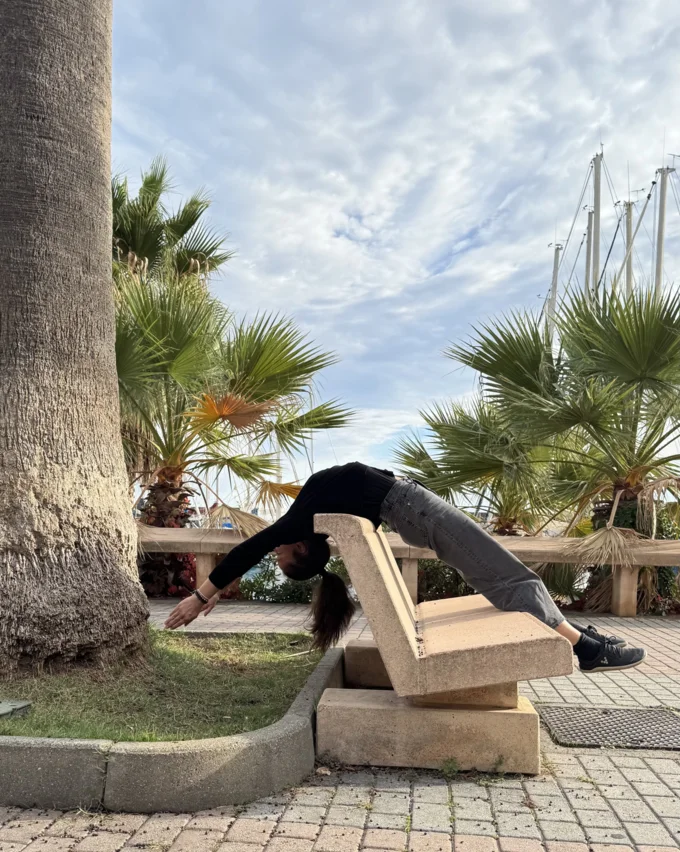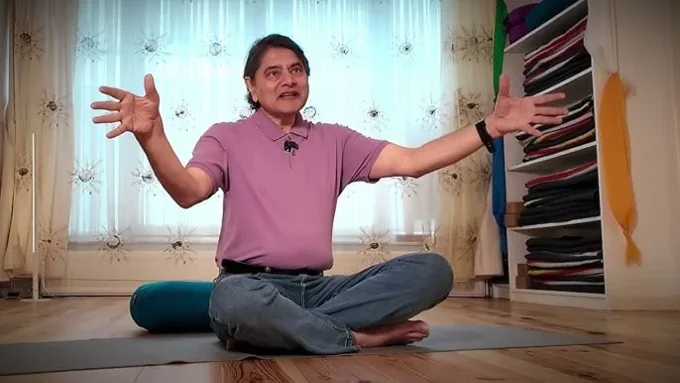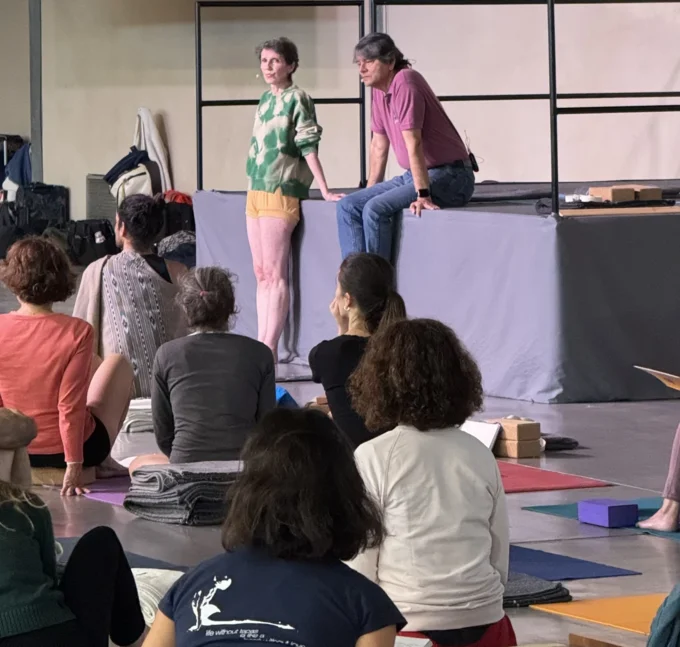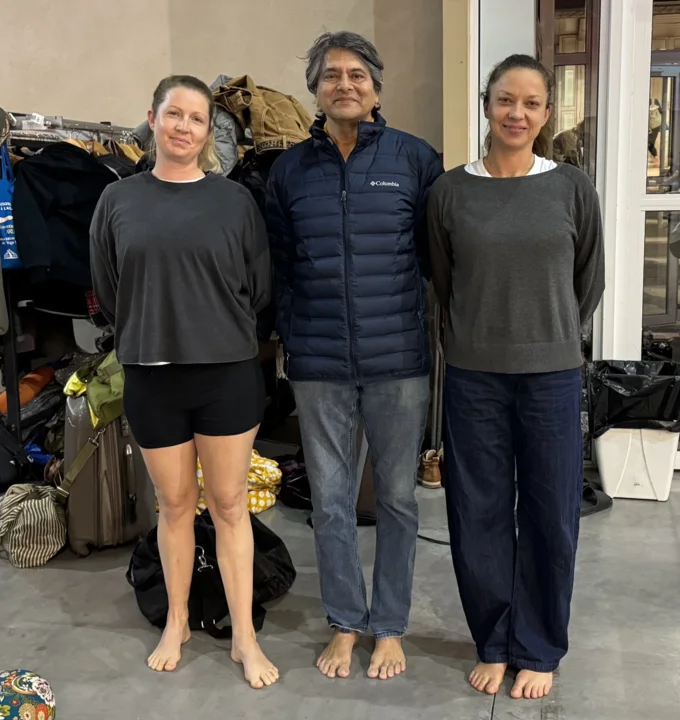The idea of traveling to France took shape last spring. Somewhere on the road to Italy, on our way to the Italian Iyengar convention with Raya Uma Datta, one of us casually said, “Next year, let’s go to France as well.” At the time, it sounded more like a joke than a plan, but the wish took root quickly.
This year, we made it happen. Our journey took us even farther, past Marseille and all the way to Arles, where on November 7, we joined the full hall in chanting Om and the Invocation to Patanjali. A thousand kilometers in one direction is no small distance, so we left early on Thursday morning, our van packed to the very last corner with yoga props.
The drive was unexpectedly smooth, especially the stretch along the coast as we passed Nice and Cannes. It was impossible not to stop, even for a moment, by the sea. The view of the wide French blue was the perfect pause before the intense days ahead.
We arrived in Arles at dusk, just in time to catch the hall still open. The space was filled with anticipation. We quickly carried in all the props, checked the layout, and sorted out the last details. Once everything was set, we headed to our room, full of adrenaline, tiredness, and the quiet sense that something special had just begun.

Birjoo Mehta
Birjoo Mehta is an experienced Iyengar yoga teacher from Mumbai, who began practicing in the 1970s and studied directly with B. K. S. Iyengar from the very beginning. In his professional life, he worked as an engineer at Tata Communications, a background that shaped his analytical, clear, and methodical approach to practice.
He spent many decades traveling worldwide, where he demonstrated the key principles of Guruji’s method and developed a remarkable ability to weave technical precision with the inner, experiential dimension of practice.

DAY 1
On the first day, Arles filled with the French Iyengar community and participants from many European countries. The convention was organized by the French Iyengar Yoga Association (AFYI), founded in 1991 and today bringing together nearly three thousand members and more than five hundred teachers across France. Its mission remains clear – to preserve the teachings of B. K. S. Iyengar, to build community and to ensure high-quality education.
This year’s convention carried the theme “Towards a fair practice, from effort to ease.” The opening talk highlighted two fundamental aspects of practice – the steady, committed effort described in Yoga Sutra 1.14 and the quiet ease of asana when effort recedes, as expressed in Sutra 2.47. These two poles are not in conflict but form a balance that can only be felt through attentive observation of body and breath.
The program was divided into two parts. Until Sunday it was open to all practitioners, while Monday and Tuesday were reserved for certified teachers, who continued with deeper, more technical study. This structure created a natural balance between the broader community and the continuing education of teachers.
The first day was dedicated to exploring the five elements, fundamental in both Ayurveda and yoga. We began seated in Svastikasana, connecting to each element through the breath.
Earth – stability, structure, support
Water – fluidity, adaptability, softness
Fire – heat, strength, clarity
Air – lightness, expansion, spreading
Ether – space, silence, subtlety
The work was based on inhale, exhale and kumbhaka. We first sensed the elements in stillness, then carried this awareness into the standing practice.
In Tadasana, Vrkshasana, the Virabhadrasana variations, Ardha Chandrasana, Parsvakonasana and Prasarita Padottanasana, the elements intertwined in every movement. As we moved from the stillness of seated practice into standing asanas, the practice gained a new depth. The elements stopped being theoretical – they became a felt experience that guided attention inward.
The morning ended in ether, in that delicate, spacious quietness that connects everything and, for a moment, completely stills the room – and us.
DAY 2
The second day was dedicated to pranayama, which Birjoo introduced through personal stories and a carefully guided practice.
He explained that he began studying directly with Guruji in 1974. In Pune there was a clear rule – two years of asana before beginning pranayama. It was not a restriction but a way to prepare the body and nervous system for the more subtle work of the breath.
We began in prone Savasana, then continued into Anantasana, observing the lateral breath. Birjoo repeated the name of the posture several times so it would settle into both body and mind.
The seated postures – including Bharadvajasana and Marichyasana III – were a continuation of the more inward part of the practice. Throughout the session we worked with the bandhas, especially Jalandhara Bandha and Mula Bandha, to direct the attention inward. Whenever concentration dispersed, we returned to Anantasana, not always physically, but often as an inner memory, a program already imprinted in the body.
Birjoo explained that we can return to Anantasana even without movement – simply by recalling the quality we created there. Some felt it in the neck and head, as lift, extension and space. Others sensed it more in the sacrum and lower back, as a soft natural lengthening and inner quiet.
When we released the bandhas, something surprising happened – a silence arose that went beyond technique. It felt as if time paused for a moment. Several practitioners described that they no longer felt the body in the usual way – as if the form dissolved and only width, lightness or an inner spaciousness remained.
This returning to Anantasana became a thread woven through all days – a shift from technique to bodily response, from shape to quality, from posture to inner experience.
Over time, Anantasana became more than a pose. It became a reference point, an internal anchor we could return to whenever we needed length, quiet or space, no matter which asana we were in.
Birjoo also explained the connection with the nadis – Ida, Pingala and Sushumna, which regulate energetic currents and open the path toward the inner limbs of yoga.
He linked pranayama to the eight-limbed path:
yama, niyama, asana, pranayama, pratyahara, dharana, dhyana, samadhi.
When breath, elements and bandhas aligned, a state between Dharana and Dhyana appeared – a moment of quiet focus created not by effort but by inner stillness.
Afternoon Session
The afternoon practice was dedicated to observation, what Birjoo described as working with vayu, the subtle movement of prana that awakens the intelligence of the body.
We observed the extended arm – first in Urdhva Hastasana, then with the arms opened to the sides. When the muscles stopped “doing,” awareness began to lead.
Birjoo integrated the five vayus into the work:
- Apana Vayu – downward energy, release, grounding
- Samana Vayu – central energy, balance, assimilation
- Prana Vayu – upward energy, inhalation, expansion
- Udana Vayu – expressive energy, uplift, clarity
- Vyana Vayu – circulating energy, integration throughout the whole body
As we applied these principles, the practice became quiet and clear.
In Urdhva Mukha Svanasana, the body rose through expansion rather than strength.
In Supta Padangusthasana I and II, we observed the skin meeting the floor – attention changed the muscle tone and the breath softened.
The afternoon practice became a bridge between the physical and the inner work.

DAY 3
"Observation itself gives stillness. The whole body becomes adjusted perfectly.
You don’t have to see all parts; if the whole body becomes still, all parts of the body become still.
If you are silent, the universe becomes silent." – Birjoo Mehta
On Sunday, everything came together. Some insights will unfold only years from now, yet the feeling that was present during the practice, and long after it ended, is what truly remains. The body remembers. The mind records.
Birjoo shared another essential idea:
"Any asana can be used if you manifest what you experience.
When you register a certain state, you can recall it.
And when you find a state in one asana, you can bring it into every asana."
We experienced exactly this. In Anantasana, we established a sense of clarity, length and silence, and then carried that state into more demanding postures like Urdhva Mukha Svanasana and Ustrasana.
This principle is simple and profound at the same time: once you create an inner state, you can transfer it anywhere. Asanas are not separate islands but passages linked by inner experience.
When the Sunday practice came to an end, we left the hall with that same quiet presence. Because of the long journey ahead, we started driving home in the afternoon, still holding the calm that had accumulated over the days. It felt as if part of the silence from the hall travelled with us in the car, staying with us for hours – a gentle reminder that true practice moves with us, wherever we go.

From these three days it became clear that yoga has never been only stretching or building strength. It is a practice that opens a space of silence, steadiness, observation and subtle layers that cannot be reached quickly. Some forms of pranayama that I practise at home had already revealed moments of quiet, but Dharana and Dhyana showed that there is something much deeper to explore.
The convention confirmed what many of us already sense: yoga is a path that does not end. It unfolds slowly, sometimes unnoticed, sometimes in a moment of complete stillness. Every day we step onto the mat is a new beginning.
Perhaps this is its greatest gift: yoga is a living process. It changes us, just as we change it. Some insights appear only when we are ready to hear them.
Yoga follows us beyond the mat, in patience, in presence, in the way we respond to the world.
And it is beautiful that it never truly ends.


